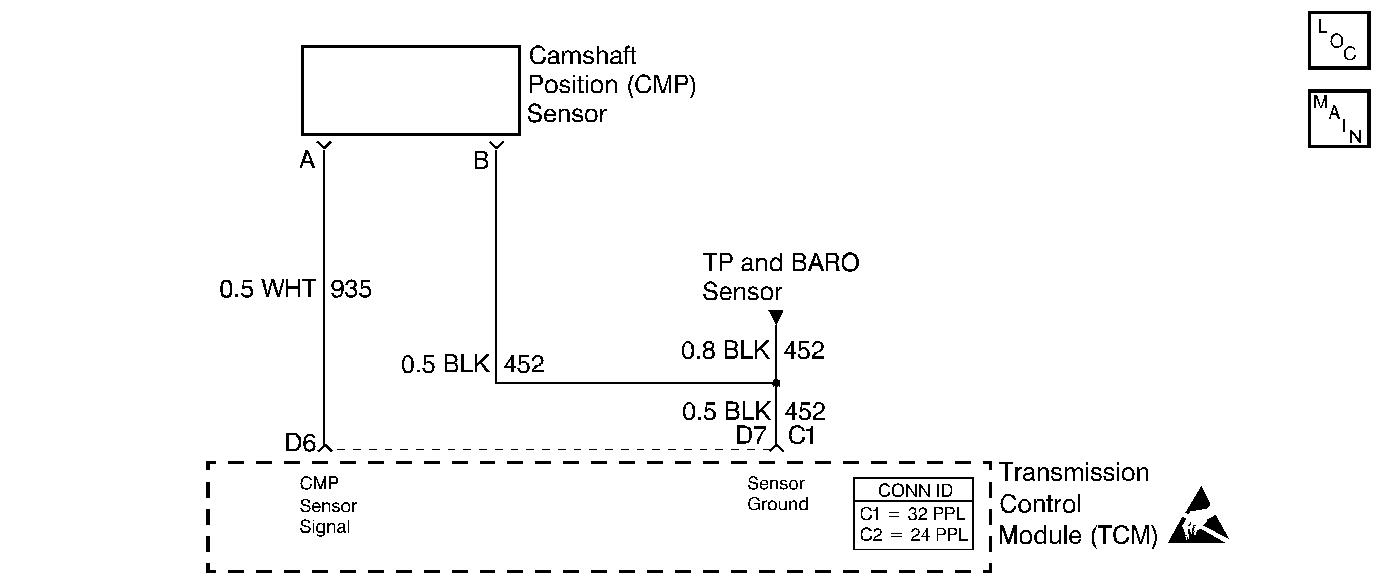DTC 71 Camshaft Position Sensor Circuit Low L57 MFI

Circuit Description
The camshaft position (CMP) sensor detects the rotational speed of the camshaft. As the camshaft rotates, an AC signal is generated in the CMP sensor. This signal provides the input to the transmission control module (TCM), to determine engine speed. The engine speed is used for various calculations including torque converter clutch (TCC) slip speed and overdrive ratio.
If the TCM detects low output signal voltage, then DTC 71 sets.
Conditions for Running the DTC
| • | No DTC 28. |
| • | Engine speed less than 50 RPM. |
| • | Transmission range indicates R, D4, D3 or D1. |
Conditions for Setting the DTC
All conditions are met for 2 seconds.
Action Taken When the DTC Sets
| • | The TCM inhibits TCC. |
| • | The TCM stores DTC 71 in TCM history. |
Conditions for Clearing the DTC
| • | A scan tool clears the DTC from TCM history. |
| • | The TCM clears the DTC from TCM history if the vehicle completes 40 consecutive key cycles without a diagnostic fault occurring. |
| • | The TCM cancels the DTC default actions when the fault no longer exists and the ignition switch is OFF long enough in order to power down the TCM. |
Diagnostic Aids
| • | Inspect the wiring at the TCM, the transmission connector and all other circuit connecting points for the following conditions: |
| - | A backed out terminal |
| - | A damaged terminal |
| - | Reduced terminal tension |
| - | A chafed wire |
| - | A broken wire inside the insulation |
| - | Moisture intrusion |
| - | Corrosion |
| • | A mechanical condition with the camshaft may set this code. With the CMP sensor removed, the camshaft and CMP sensor drive gear can be checked for damage. |
Test Description
The numbers below refer to the step numbers on the diagnostic table.
-
This step verifies the fault.
-
This step indicates that the sensor is capable of inducing an AC voltage in the circuit.
-
This step checks circuits 935 and 452 for being shorted together.
-
This step checks the entire CMP sensor circuit for proper signal output.
Step | Action | Value(s) | Yes | No |
|---|---|---|---|---|
1 | Was the Powertrain On-Board Diagnostic (OBD) System Check performed? | -- | ||
Important:: Before clearing the DTCs, use the scan tool in order to record the Failure Records. Using the Clear Info function erases the Failure Records from the TCM. Does Engine Speed on the Scan Tool increase as the engine speed increases? | -- | System OK Go to Diagnostic Aids | ||
Is the AC voltage greater than the specified value? | 0.5 volts AC | |||
4 |
Is the voltage within the specified value? | 4.0-5.2 volts DC | ||
5 | Is the voltage reading from Step 4 greater than the specified value? | 4.0-5.2 volts DC | ||
6 | Inspect circuit 935 (WHT) for a short to B+. Refer to General Electrical Diagnosis in Wiring Systems. Was a condition found? | -- | ||
7 | Connect the J 39200 DMM between terminals A and B of the CMP sensor connector. Is the voltage within the specified value? | 4.0-5.2 volts DC | ||
8 | Inspect circuit 935 (WHT) for high resistance or an open. Refer to General Electrical Diagnosis in Wiring Systems. Was a condition found? | -- | ||
9 | Are there any other sensor DTCs? | -- | ||
10 | Inspect for an open in the sensors' ground circuit 452 (BLK). Refer to General Electrical Diagnosis in Wiring Systems. Was a condition found? | -- | ||
11 | Inspect for an open in circuit 452 (BLK), from the CMP sensor connector terminal B, to the sensors' ground splice. Was a condition found? | -- | -- | |
12 | Repair the wiring as necessary. Refer to Wiring Repairs in Wiring Systems. Is the repair complete? | -- | -- | |
Is the resistance less than the specified value? | 50 kohms | |||
Is the voltage greater than the specified value? | 0.5 volts AC | |||
15 | Repair circuits 935 (WHT) and 452 (BLK) for being shorted together. Is the repair complete? | -- | -- | |
16 |
Was a condition found? | -- | ||
17 | Refer to Camshaft Replacement in Engine Mechanical, for repair of the driven gear or camshaft. Is the repair complete? | -- | -- | |
18 | Replace the CMP sensor. Is the replacement complete? | -- | -- | |
19 | Replace the TCM. Refer to Powertrain Control Module Replacement/Programming in Engine Controls. Is the replacement complete? | -- | -- | |
20 | Perform the following procedure in order to verify the repair:
Is the engine speed greater than 50 RPM for 2 seconds? | -- | System OK |
